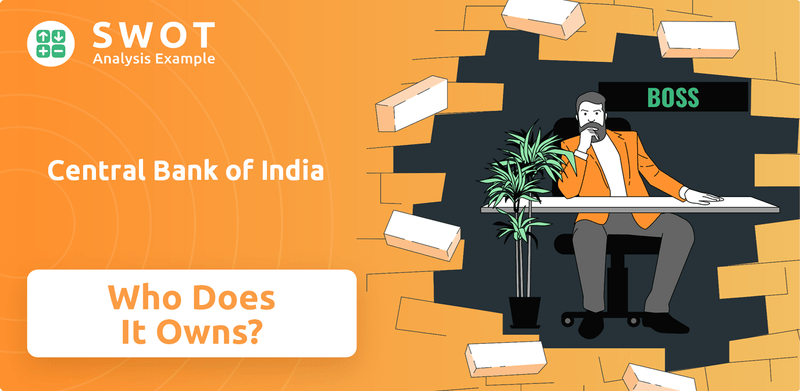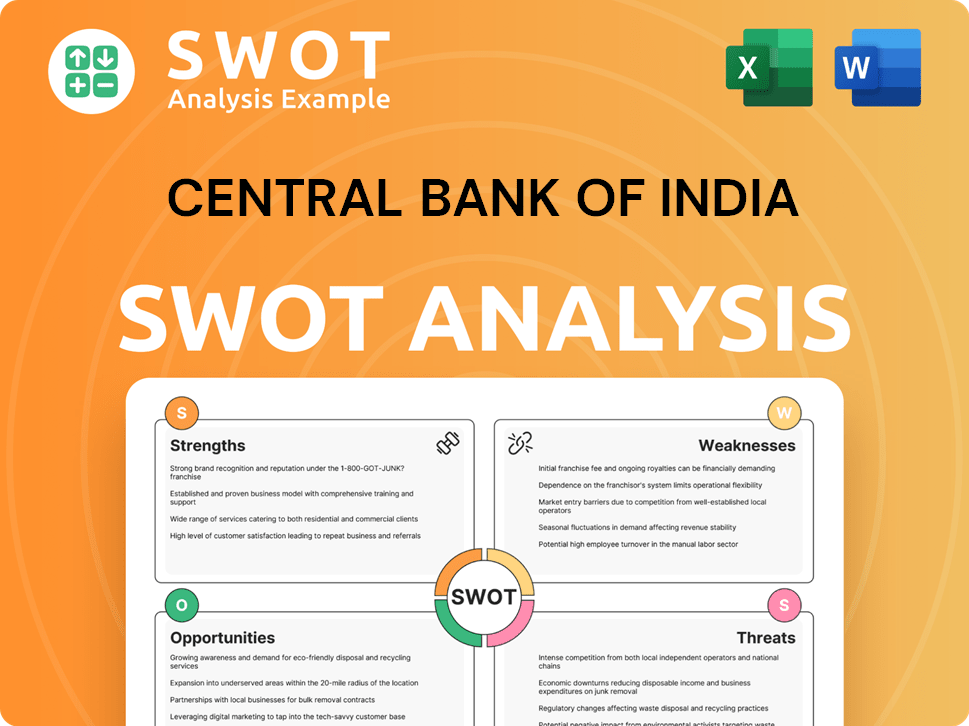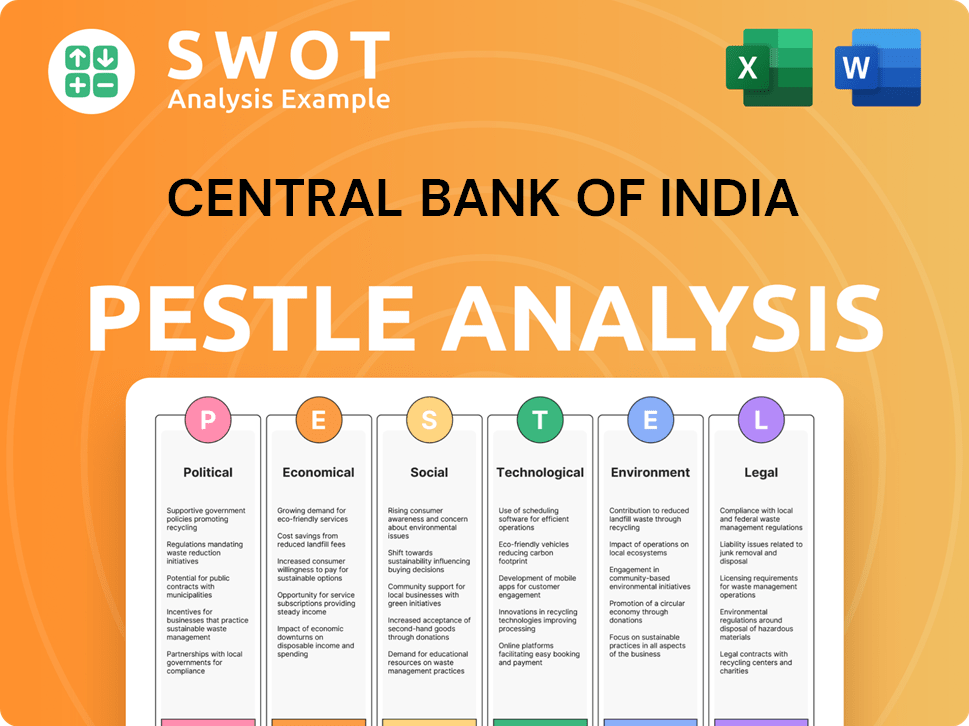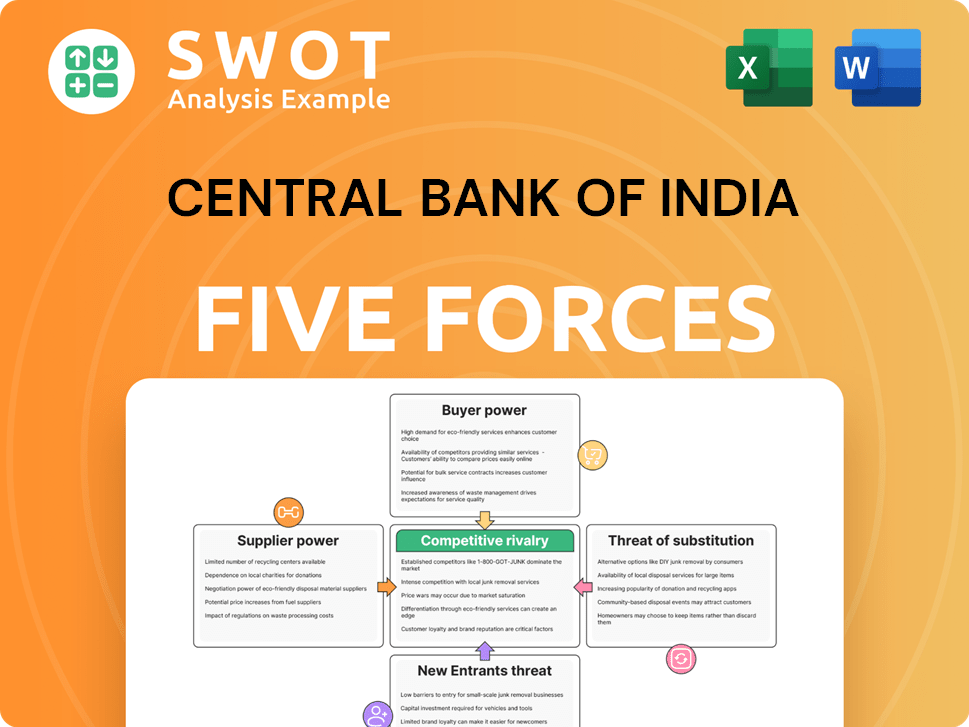Central Bank of India Bundle
Who Really Owns Central Bank of India?
Unraveling the Central Bank of India SWOT Analysis reveals more than just financial data; it unveils the very fabric of its control and strategic direction. Understanding CBI ownership is key to grasping its place in the Indian banking landscape. This exploration will dissect the bank's ownership structure, from its inception to its current status as a prominent public sector bank.

Central Bank of India's story is one of transformation, starting as a vision of Indian entrepreneurship and evolving into a cornerstone of the nation's financial system. The shift to government ownership in 1969 dramatically reshaped its destiny, making it a crucial part of India's public sector banks. This analysis of "Who owns CBI" will provide insights into its major shareholders, the government stake in Central Bank of India, and recent ownership trends impacting its future.
Who Founded Central Bank of India?
The Central Bank of India (CBI) was established on December 21, 1911, in Mumbai. Sir Sorabji Pochkhanawala founded the bank, with Sir Pherozeshah Mehta serving as its first Chairman. This marked a significant moment as it was the first commercial Indian bank entirely owned and managed by Indians.
The bank's founding was rooted in a 'Swadeshi' vision, aiming for self-reliance. Sir Sorabji Pochkhanawala famously described the Central Bank of India as 'the property of the nation and the country's asset,' highlighting its nationalistic purpose. This reflected the founders' dedication to building an institution that served the interests of India.
Early expansion saw the bank establishing branches in Hyderabad (1918) and Secunderabad (1925). A key acquisition was the Tata Industrial Bank in 1923, which included a branch in Madras that became part of CBI. The bank also facilitated the creation of the Central Exchange Bank of India in London in 1936.
Founded on December 21, 1911, in Mumbai.
Sir Sorabji Pochkhanawala.
Sir Pherozeshah Mehta.
Branches in Hyderabad (1918) and Secunderabad (1925).
Tata Industrial Bank acquired in 1923.
Established Central Exchange Bank of India in London in 1936.
The early ownership of Central Bank of India was characterized by its commitment to being 'completely owned and managed by Indians.' This focus on Indian ownership was a core principle from its inception. The bank's history reflects a strong nationalistic ethos, aiming to build a financial institution for the country. Examining the Marketing Strategy of Central Bank of India provides further context on its evolution.
- The bank's initial structure was designed to ensure control by Indian stakeholders.
- The founders' vision emphasized self-reliance and national pride.
- By 1949, CBI had over 400 branches across India.
- The bank's early success laid the groundwork for its future growth.
Central Bank of India SWOT Analysis
- Complete SWOT Breakdown
- Fully Customizable
- Editable in Excel & Word
- Professional Formatting
- Investor-Ready Format

How Has Central Bank of India’s Ownership Changed Over Time?
The Growth Strategy of Central Bank of India has been significantly shaped by its ownership structure. The most impactful event was the nationalization of Central Bank of India on July 19, 1969, along with 13 other major commercial banks. This pivotal moment transformed CBI into a state-owned entity, with the Government of India becoming its primary shareholder. This transition fundamentally altered the bank's operational framework and strategic direction, aligning it with the broader economic and social objectives of the Indian government.
The ownership of Central Bank of India, or CBI, continues to be largely dominated by the Government of India, reflecting its status as a public sector bank. The government's consistent capital infusions have been crucial in strengthening the bank's financial position and ensuring its compliance with regulatory standards. This has enabled CBI to maintain its operations and support various government initiatives.
| Shareholder Category | March 2025 (%) | September 2024 (%) |
|---|---|---|
| Government of India (Promoter) | 89.27 | 93.08 |
| Foreign Institutional Investors (FIIs) | 1.27 | 0.44 |
| Mutual Funds | 0.22 | 0.13 |
| Insurance Companies | 3.47 | 2.69 |
| Financial Institutions | 1.65 | 0.00 |
| Other Institutional Investors | 0.57 | 0.01 |
| Non-Institutional Investors (Indian Public and Others) | 3.58 | 3.65 |
As of March 2025, the Government of India holds a substantial majority stake of 89.27% in Central Bank of India. This demonstrates the government's enduring control over CBI and its commitment to the bank's stability. The remaining shares are distributed among various institutional and retail investors. Foreign Institutional Investors (FIIs) increased their holdings to 1.27%, and Mutual Funds increased their holdings to 0.22%. Insurance Companies have increased their holdings to 3.47%. These shifts indicate a growing interest from institutional investors, while the government maintains its influential role in the bank's strategic decisions and operational oversight.
The ownership of Central Bank of India is primarily held by the Government of India.
- The Government of India holds 89.27% of the shares as of March 2025.
- FIIs and Mutual Funds have increased their holdings.
- The government's stake reflects its control and influence over the bank.
- The bank's ownership structure impacts its strategic direction.
Central Bank of India PESTLE Analysis
- Covers All 6 PESTLE Categories
- No Research Needed – Save Hours of Work
- Built by Experts, Trusted by Consultants
- Instant Download, Ready to Use
- 100% Editable, Fully Customizable

Who Sits on Central Bank of India’s Board?
The current Board of Directors of Central Bank of India, as of 2024, is pivotal in guiding the bank's strategic direction and ensuring robust governance. Key figures include Matam Venkata Rao as Managing Director & CEO, and Vivek Wahi as Executive Director. Non-Executive & Independent Directors include Dinesh Pangtey and Pradip Pranlal Khimani. Hardik Mukesh Sheth serves as a Nominee (Govt) on the board. The full list of board members is available on the bank's official website and in its corporate filings. Regular board meetings are held to discuss financial results and other critical corporate matters, with meetings scheduled for October 17, 2024, and January 20, 2025.
These board members oversee the operations and strategic initiatives of Central Bank of India. The board's composition and activities are crucial in maintaining the bank's financial health and compliance with regulatory standards. The board's role is essential for the effective management and sustainable growth of the bank, ensuring that it meets its financial goals and serves its stakeholders effectively.
| Board Member | Position | Status |
|---|---|---|
| Matam Venkata Rao | Managing Director & CEO | Current |
| Vivek Wahi | Executive Director | Current |
| Dinesh Pangtey | Non-Executive & Independent Director | Current |
| Pradip Pranlal Khimani | Non-Executive & Independent Director | Current |
| Hardik Mukesh Sheth | Nominee (Govt) | Current |
The Government of India, as the majority shareholder of Central Bank of India, significantly influences the bank's decision-making processes. With an ownership stake of 89.27% as of March 2025, the government's control is substantial. This high level of government ownership directly impacts major resolutions and appointments within the bank. The government's strong backing is a key factor in maintaining the bank's financial stability and capital position, including providing timely equity infusions. To understand how the bank targets its customers, consider exploring the Target Market of Central Bank of India.
Central Bank of India's ownership structure is heavily influenced by the Government of India, which holds a significant majority stake. This ownership structure means the government has considerable control over the bank's strategic decisions and overall direction.
- Government ownership provides financial stability.
- Board decisions are significantly influenced by government representation.
- The bank is classified as a public sector bank due to government ownership.
- The government's stake influences the bank's financial performance.
Central Bank of India Business Model Canvas
- Complete 9-Block Business Model Canvas
- Effortlessly Communicate Your Business Strategy
- Investor-Ready BMC Format
- 100% Editable and Customizable
- Clear and Structured Layout

What Recent Changes Have Shaped Central Bank of India’s Ownership Landscape?
Over the past few years, the ownership structure of Central Bank of India (CBI) has seen shifts, though the Government of India remains the primary shareholder. As of March 2025, the government's stake decreased to 89.27% from 93.08% in September 2024. This aligns with the government's plan to reduce its holdings in public sector banks to meet minimum public shareholding (MPS) norms, which require listed companies to have a 25% public shareholding by August 2026, although government-owned firms have an exemption.
Institutional investor participation has increased. Foreign Institutional Investors (FIIs) raised their holdings from 0.44% in December 2024 to 1.27% by March 2025. Mutual Funds increased their holdings from 0.13% to 0.22% during the same period. Insurance companies' holdings rose to 3.47% in March 2025, up from 2.69% in September 2024. These changes suggest a gradual diversification of the ownership base of Central Bank of India, despite continued government control. Discussions about potential stake sales via qualified institutional placements (QIP) or direct sales to large investors have been reported in early 2025.
In June 2025, Central Bank of India acquired a 24.91% stake in Future Generali India Insurance Company Ltd. (FGIICL) for up to ₹451 crore, entering the insurance sector. The bank's financial performance improved, with a 28% increase in net profit to ₹1,034 crore in Q4 FY25. There have been no official announcements regarding potential mergers with other public sector banks as of May 2025.
| Ownership Category | September 2024 | March 2025 |
|---|---|---|
| Government of India | 93.08% | 89.27% |
| Foreign Institutional Investors (FIIs) | 0.44% | 1.27% |
| Mutual Funds | 0.13% | 0.22% |
| Insurance Companies | 2.69% | 3.47% |
The Government of India is the primary owner of Central Bank of India.
The ownership structure includes the government, FIIs, Mutual Funds, and Insurance Companies.
The government's stake is decreasing, with increasing participation from institutional investors.
The government's stake decreased to 89.27% as of March 2025.
Central Bank of India Porter's Five Forces Analysis
- Covers All 5 Competitive Forces in Detail
- Structured for Consultants, Students, and Founders
- 100% Editable in Microsoft Word & Excel
- Instant Digital Download – Use Immediately
- Compatible with Mac & PC – Fully Unlocked

Related Blogs
- What are Mission Vision & Core Values of Central Bank of India Company?
- What is Competitive Landscape of Central Bank of India Company?
- What is Growth Strategy and Future Prospects of Central Bank of India Company?
- How Does Central Bank of India Company Work?
- What is Sales and Marketing Strategy of Central Bank of India Company?
- What is Brief History of Central Bank of India Company?
- What is Customer Demographics and Target Market of Central Bank of India Company?
Disclaimer
All information, articles, and product details provided on this website are for general informational and educational purposes only. We do not claim any ownership over, nor do we intend to infringe upon, any trademarks, copyrights, logos, brand names, or other intellectual property mentioned or depicted on this site. Such intellectual property remains the property of its respective owners, and any references here are made solely for identification or informational purposes, without implying any affiliation, endorsement, or partnership.
We make no representations or warranties, express or implied, regarding the accuracy, completeness, or suitability of any content or products presented. Nothing on this website should be construed as legal, tax, investment, financial, medical, or other professional advice. In addition, no part of this site—including articles or product references—constitutes a solicitation, recommendation, endorsement, advertisement, or offer to buy or sell any securities, franchises, or other financial instruments, particularly in jurisdictions where such activity would be unlawful.
All content is of a general nature and may not address the specific circumstances of any individual or entity. It is not a substitute for professional advice or services. Any actions you take based on the information provided here are strictly at your own risk. You accept full responsibility for any decisions or outcomes arising from your use of this website and agree to release us from any liability in connection with your use of, or reliance upon, the content or products found herein.